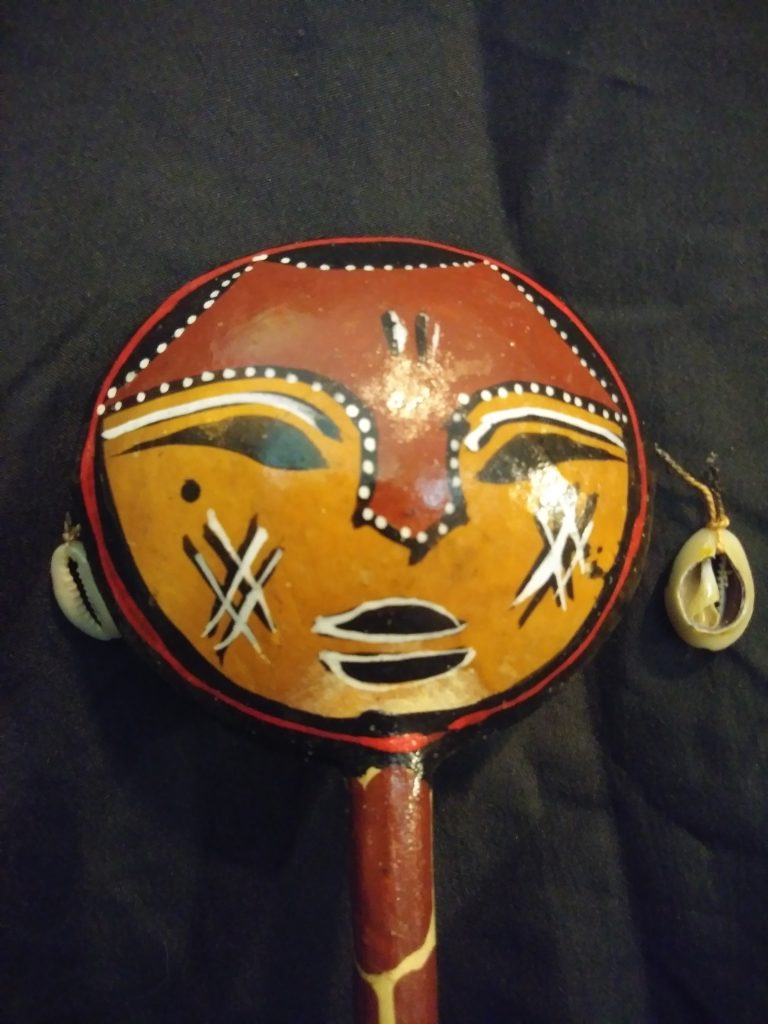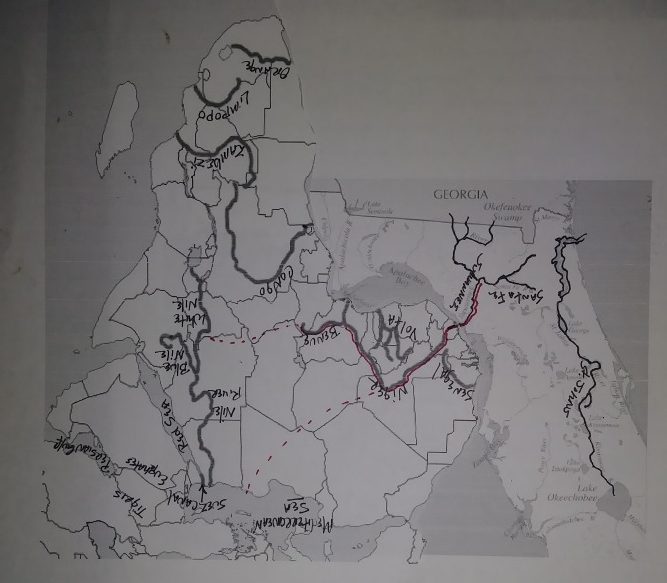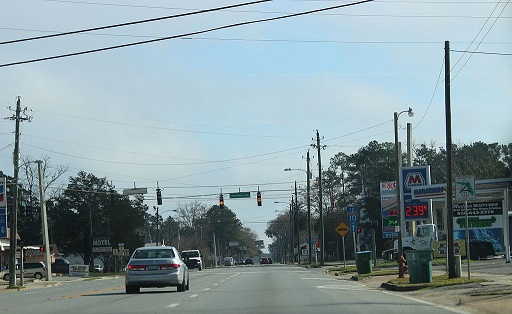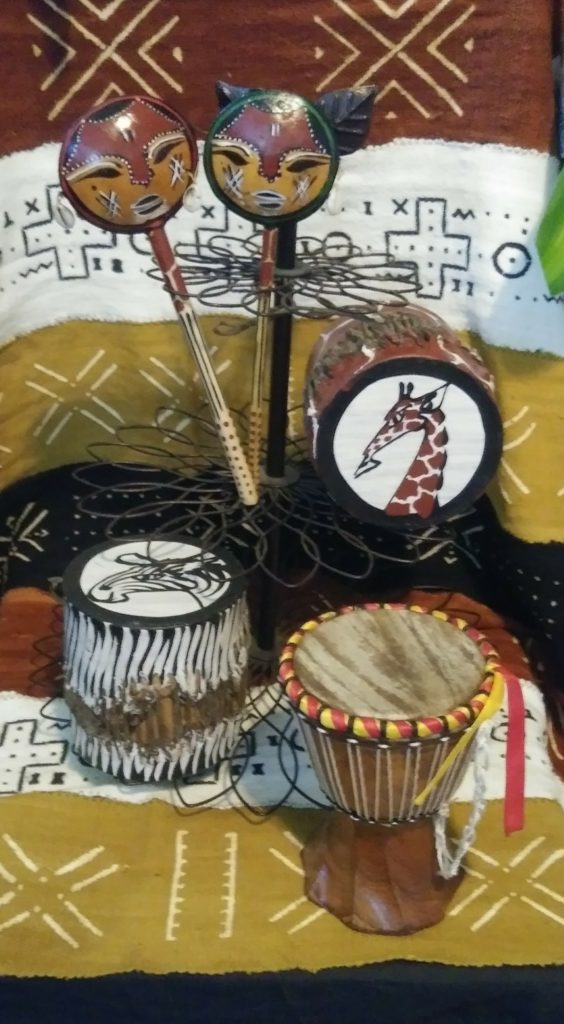African Gifts, Fossils & Artifacts Shop
There are some places in Florida where you can close your eyes, open your mind and heart, and feel the heartbeat of the Earth.
In your mind you creep into a dark green hammock and let the hot, wet air close in around you. Vines sway slightly in a almost non existent breeze and mosquitoes buzz past your ears. Cicadas chatter and buzz in the backdrop like theme music and somewhere in the distance the cry of a strange bird rises to the forefront. Lead singer….
Drums beat under your feet and a strange feeling begins to come over you. You no longer know where you are but you still have not opened your eyes… Are you still in Florida? Still safely contained in the United States of America?
The answer is yes… and no….
Those drum beats deep within the Paleozoic layers of Florida’s Earthly crust do not come from anything local at all. Those are ancient drum beats, calling from the Motherland… Mother Africa.
Why are Floridians so strange? Why is Florida such an odd place? Maybe this is the reason why only this place in all of this country is so wild and free… So ancient yet so new… Maybe not really so strange at all.
Read on my friends and let’s begin at the very beginning…
Let me show you why La Florida is such a special place and why it still may hold the keys to some very old mysteries from the dawn of mankind…
I believe the Earth is much, much older than we are able to prove with science. With that said, Gaia has changed her clothes many times over many years; but we will begin with 300 Million years ago, when the idea of our very existence as humans, floated around on large land masses in an infinite ocean. Florida was part of one of those lands. Gondwana, the continent which would later split apart to become Africa and South America. A land mass that would break apart and become the world as we know it.
Florida has Never Quite “Fit In”
Africa is a very large continent. The second largest in the world but it used to be bigger. Much bigger. In fact, it used to be solidly attached to the North American continent on the Gulf of Mexico side of Florida. Everything was all one big piece of land with Florida actually being surrounded by mostly desert, the Sahara desert, in the middle of it all. Not an ocean in sight. On the other hand, let us remember that the Sahara once was an immense rainforest; and what made it that rainforest is still a little bit of a mystery.
It took three world events to break Pangaea apart completely. It was the first one that left behind a small portion of that continent and country that would later be named Africa.
Florida would be the piece that was left behind.
Yes folks, the bedrock of Florida is actually African and over 300 million years old. It’s a foundation that comes from ancient days when the Earth was still new and fresh. Untainted. Unpolluted.

When North America was first created, Florida was attached but only in spirit. Most of Florida was covered in water and there was a huge channel that separated it from the rest of the continent.
Considered “exotic terrains” by geologists, the bedrock of the Suwannee River area and all of South Florida, actually shares more characteristics with Africa than North America.
https://fcit.usf.edu/florida/lessons/land/land.htm
https://www.sciencedaily.com/releases/2016/11/161130141053.htm
African Gifts, Fossils & Artifacts Shop
The Garden of Eden – Apalachicola Florida
Once one has learned the Prehistoric origins of the beautiful state of Florida, the following tale might make one think twice about what they think they know… About everything…
And the Lord God planted a garden in Eden, in the east, and there he put the man whom he had formed. 9 And out of the ground the Lord God made to spring up every tree that is pleasant to the sight and good for food. The tree of life was in the midst of the garden, and the tree of the knowledge of good and evil.
10 A river flowed out of Eden to water the garden, and there it divided and became four rivers. 11 The name of the first is the Pishon. It is the one that flowed around the whole land of Havilah, where there is gold. 12 And the gold of that land is good; bdellium and onyx stone are there. 13 The name of the second river is the Gihon. It is the one that flowed around the whole land of Cush. 14 And the name of the third river is theTigris, which flows east of Assyria. And the fourth river is the Euphrates. Genesis 2:10-14
Lands of Eden, Cush, Havilah, and Assyria.
Rivers are: The one which came out of Eden, Pishon, Gihon, Tigris and Euphrates
Stones and Bedrock – Gold, Bdellium and Onyx
Yup, that is the story from the Bible up there and those are the points of geological interest from that story. None of which are in Florida… At this present time, but if you look at the approximate position of the state of Florida where it was attached to West Africa more than 300 million years ago, things may look a little different.

First off, you have to turn your map of Africa upside down. Then place your map of Africa right in the rounded part on the West coast of Florida. See how the two fit together? Now what is really interesting is where the Niger river meets the Suwannee. They meet almost exactly together if you fit the map together right. No the scale isn’t correct, and yes it is purely theory but if you squint your eyes…
Strange geological coincidence? We sure do have quite a few of them. Another one related to this particular situation is the St. John’s River. Where the majority of the rivers in the world run South, the St. John’s river and the Nile river are two that do not. They run North. I will leave it up to you readers to investigate the magnetic anamoly left over from the continental split that may have something to do with that, on your own. You can determine whether it is the slope of the river that causes it to run north, or something else… and you are more than welcome to repeat that beloved old Florida saying “only two rivers in th e world run North, the St. John’s and the Nile.” May not be true, but I’ve heard it all my life.
So where is all this going? What has any of this have to do with the Garden of Eden? Well… Let’s head out west of Tallahasse near the banks of the Apalachacola River to Bristol, Fl.

Good ol’ Bristol… Wouldn’t imagine that the Garden of Eden was here would you? Well… God didn’t want it to ever be found by mankind again so….
Anyways.
Back in the 1950’s Mr. Elvy Edison Callaway seemed to think that he had found one of the lost secrets of the world. He was no crazy guy either, in fact, in 1936 he ran for Florida governor. Not that that doesn’t make him a crazy guy but… you know, he was.. established.
Having grown up in Alabama and having been kicked out of the Baptist church there for square dancing, Mr. Callaway soon proved himself to be a different sort of human in the south. He arrived in Lakeland, Florida in the 1920’s and became a lawyer for the NAACP. Things were going well for him then he decided to run for governor and lost.
This must have hurt. Callaway started fraternizing with a metaphysical inspirational writer from Winter Park. Next thing you know, the speaker tells Callaway he needs to move up north towards Tallahassee and buy some land. Callaway gets divorced from his wife of 30 years and does what he is told. Bristol must have been quite beautiful to him, it is where he bought this land.
As it turned out, it was also the home to a very special tree and plants that grew no where else in the world. Callaway became obsessed that it was the Garden of Eden and turned the entire area into a park in 1956, an attraction that one can still go explore today.
The idea was not too far fetched. The Appalachee Bay does have four rivers that feed it right now. The Ochlockonee, St. Marks, Econfina, and Aucilla rivers all flow into it. It also geographically used to be part of Africa. Strangely enough if you meet the two continents up on the map the Niger river pairs right up to the Suwannee and the Apalachee Bay could very well have been a prehistoric lake of some sort. A possible precurser to the 300 million year old Gulf of Mexico.
If you look at the two continents together, the four rivers running out of the Apalachee Bay would be: The Niger, which could have once been all one river if it had ever joined with the Tigris. The Volta, which in the same token could have once been joined with the Euphrates. The Benue which could have continued on to be the Nile and the Congo which could have been the Pishon.
It’s an interesting theory.
Back to Mr. Callaway… He was also an amateur botanist and his main theories were based on the legendary Torreya tree which only grows in Bristol. There are other plants in the area that only grow in that place, but The Torreya is the most important. Mainly because it is also called “gopherwood”. Why would that be important? Because later on Ol’ Noah, would go on to build his Ark out of…. Wait for it….
Gopherwood.
13 Then God said to Noah, 典he end of all living creatures has come before Me, because through them the earth is full of violence. Now behold, I will destroy both them and the earth. 14 Make for yourself an ark of gopherwood; make rooms in the ark and coat it with pitch inside and out . Genesis 6:13-14
The only place in the world “gopherwood” seems to grow is Torreya State Park in Apalachicola, Florida. A remnant of ancient times, left behind in a strange land as the rest of it’s home moved far away across the Atlantic… and no matter what one might hear about the Garden of Eden, it will always come down to one very special tree…
African Gifts, Fossils & Artifacts Shop
https://answersingenesis.org/genesis/garden-of-eden/where-was-the-garden-of-eden-located/
https://www.atlasobscura.com/places/garden-of-eden-trail
Paradise Lust: The Lawyer Who Found Eden along the Florida Panhandle
https://www.exploresouthernhistory.com/apalachicolabluffs2.html
https://e360.yale.edu/features/for-endangered-florida-tree-how-far-to-go-to-save-a-species-torreya
